Hexagonal Tessellation Study Guide
Definition
A hexagonal tessellation is a pattern of regular hexagons that fit together without any gaps or overlaps to cover a flat surface, such as a floor or a wall.
Characteristics
- Hexagonal tessellations are made up of regular hexagons, which are six-sided polygons with equal side lengths and equal interior angles.
- Each hexagon in the tessellation shares a side with adjacent hexagons.
- The pattern can continue infinitely in all directions.
Examples
Hexagonal tessellations can be found in nature, such as in the honeycomb structures built by bees. They are also commonly used in design and architecture, including tiling patterns and decorative motifs.
Mathematical Properties
To create a hexagonal tessellation, the interior angles of the hexagons must sum to 360 degrees, and the side lengths of the hexagons must be equal to ensure a perfect fit without any gaps or overlaps.
Study Tips
- Practice identifying regular hexagons and understanding their properties, such as interior angles and side lengths.
- Explore real-world examples of hexagonal tessellations to see how they are used in different contexts.
- Experiment with creating your own hexagonal tessellations using paper or digital tools, paying attention to the precise fit of the hexagons.
◂Math Worksheets and Study Guides Eighth Grade. Three dimensional geometry/Measurement
Study Guide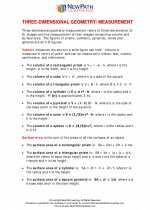 Three dimensional geometry/Measurement
Three dimensional geometry/Measurement  Worksheet/Answer key
Worksheet/Answer key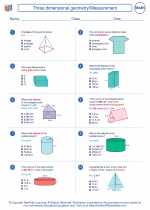 Three dimensional geometry/Measurement
Three dimensional geometry/Measurement  Worksheet/Answer key
Worksheet/Answer key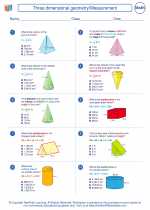 Three dimensional geometry/Measurement
Three dimensional geometry/Measurement  Worksheet/Answer key
Worksheet/Answer key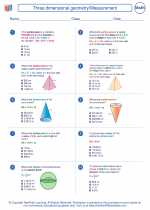 Three dimensional geometry/Measurement
Three dimensional geometry/Measurement  Worksheet/Answer key
Worksheet/Answer key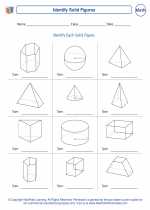 Identify Solid Figures
Identify Solid Figures  Worksheet/Answer key
Worksheet/Answer key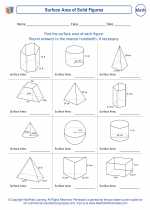 Surface Area of Solid Figures
Surface Area of Solid Figures  Worksheet/Answer key
Worksheet/Answer key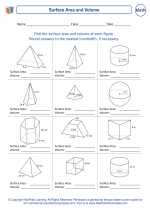 Surface Area and Volume
Surface Area and Volume  Worksheet/Answer key
Worksheet/Answer key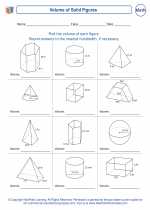 Volume of Solid Figures
Volume of Solid Figures  Worksheet/Answer key
Worksheet/Answer key Surface Area and Volume
Surface Area and Volume  Worksheet/Answer key
Worksheet/Answer key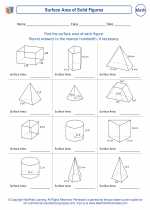 Surface Area of Solid Figures
Surface Area of Solid Figures  Worksheet/Answer key
Worksheet/Answer key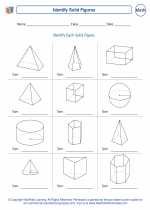 Identify Solid Figures
Identify Solid Figures  Worksheet/Answer key
Worksheet/Answer key Volume of Solid Figures
Volume of Solid Figures 

 Worksheet/Answer key
Worksheet/Answer key
 Worksheet/Answer key
Worksheet/Answer key
 Worksheet/Answer key
Worksheet/Answer key
 Worksheet/Answer key
Worksheet/Answer key
 Worksheet/Answer key
Worksheet/Answer key
 Worksheet/Answer key
Worksheet/Answer key
 Worksheet/Answer key
Worksheet/Answer key
 Worksheet/Answer key
Worksheet/Answer key
 Worksheet/Answer key
Worksheet/Answer key
 Worksheet/Answer key
Worksheet/Answer key
 Worksheet/Answer key
Worksheet/Answer key

The resources above cover the following skills:
Geometry (NCTM)
Analyze characteristics and properties of two- and three-dimensional geometric shapes and develop mathematical arguments about geometric relationships.
Precisely describe, classify, and understand relationships among types of two- and three-dimensional objects using their defining properties.
Use visualization, spatial reasoning, and geometric modeling to solve problems.
Use geometric models to represent and explain numerical and algebraic relationships.
Measurement (NCTM)
Apply appropriate techniques, tools, and formulas to determine measurements.
Select and apply techniques and tools to accurately find length, area, volume, and angle measures to appropriate levels of precision.
Develop strategies to determine the surface area and volume of selected prisms, pyramids, and cylinders.